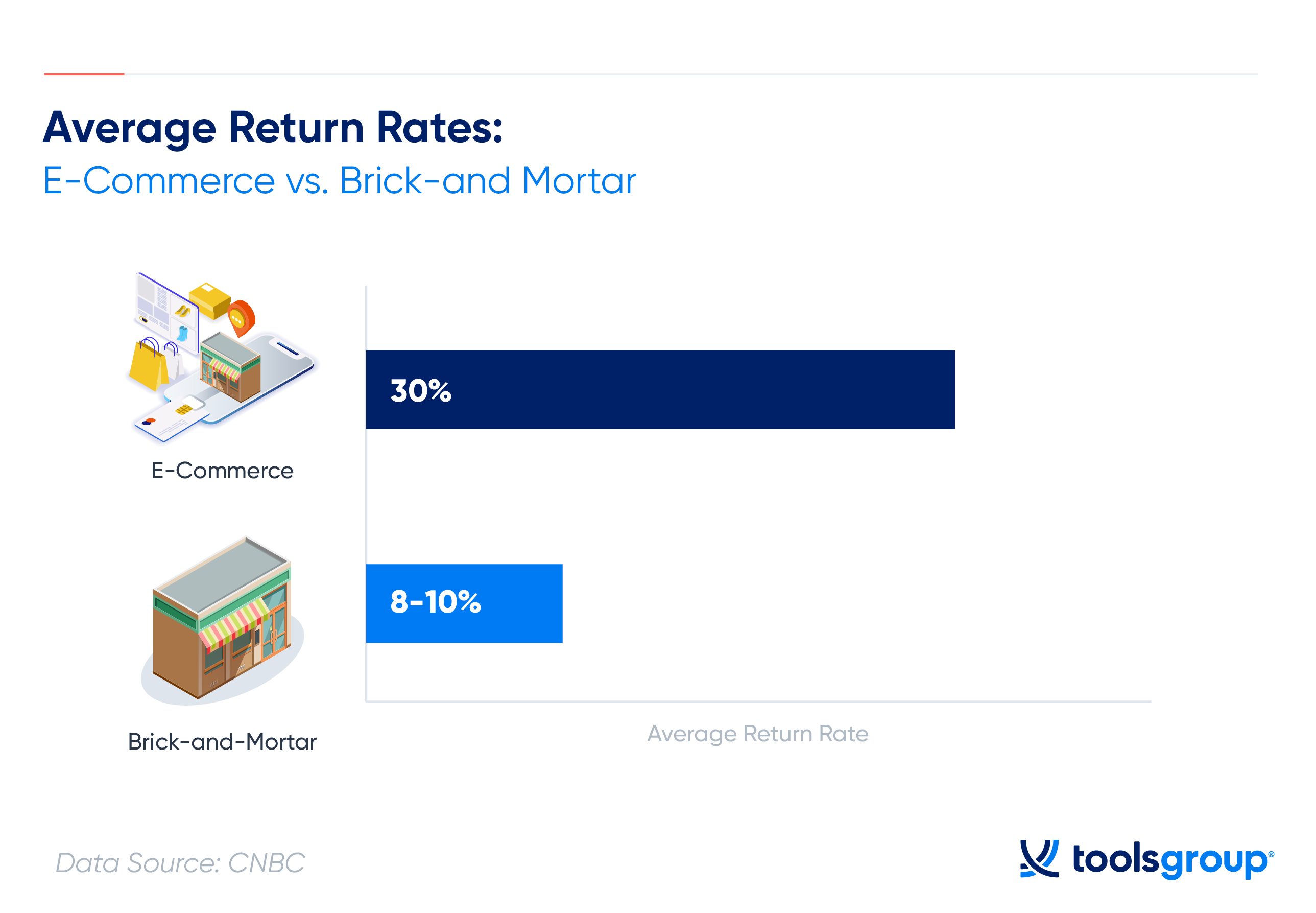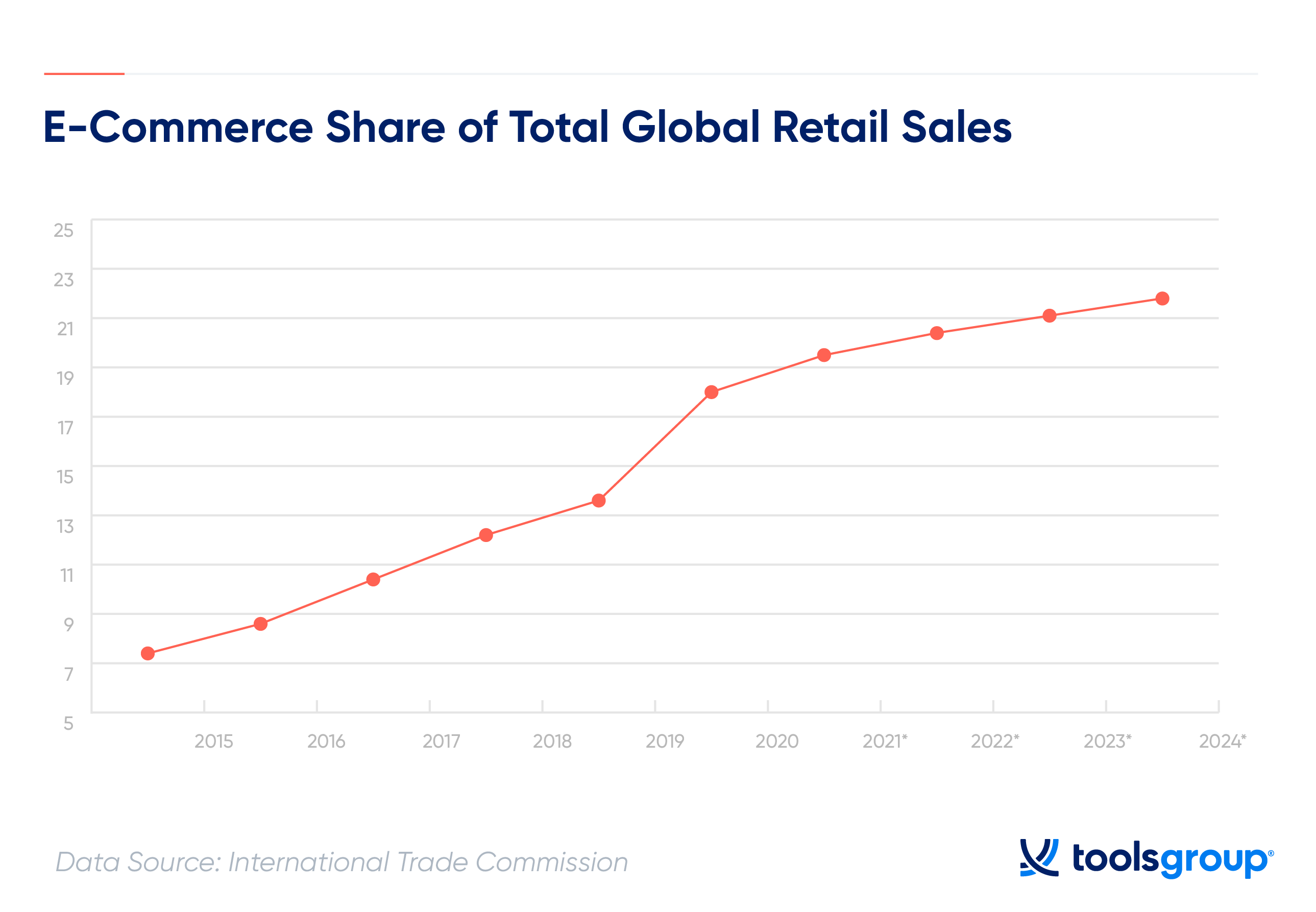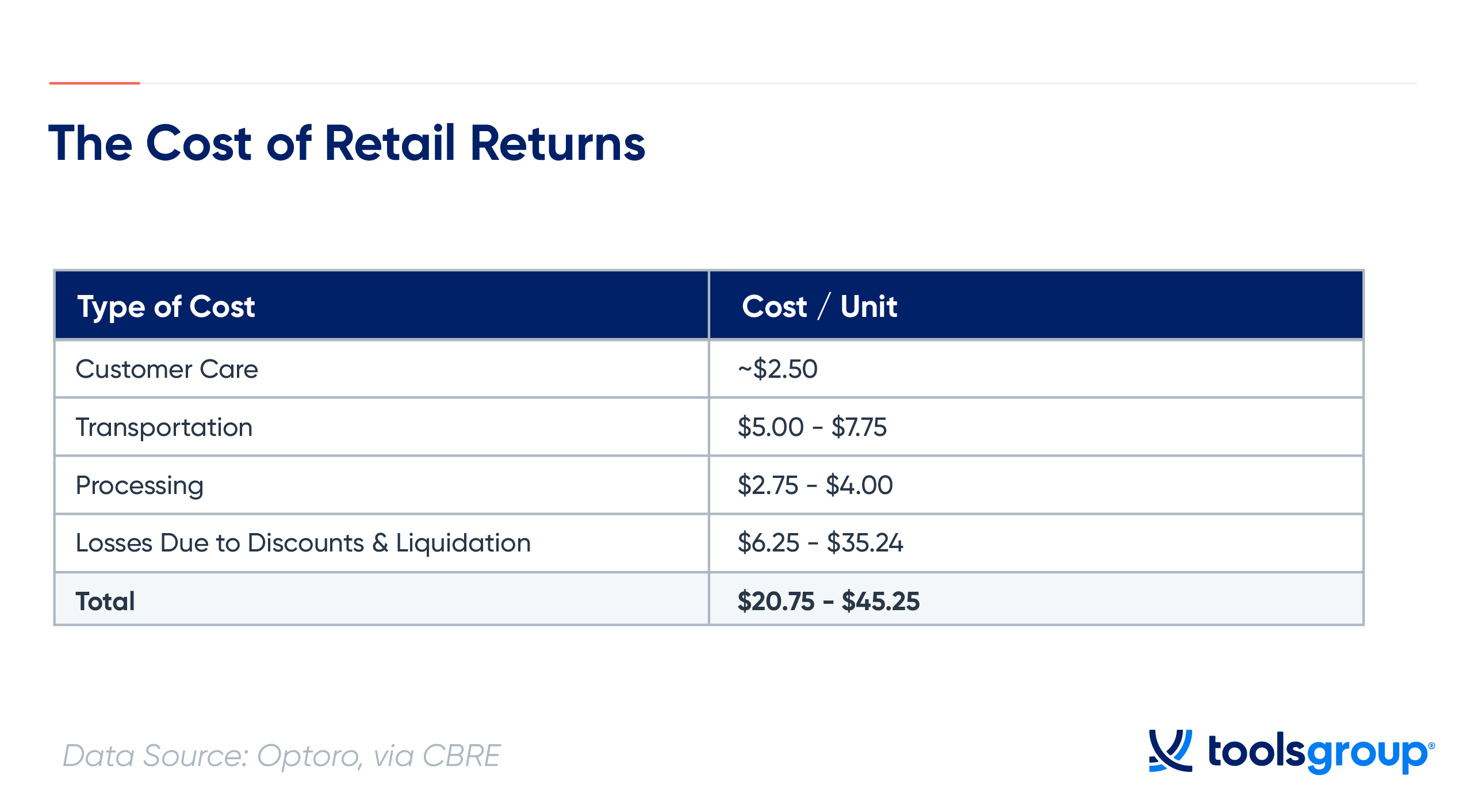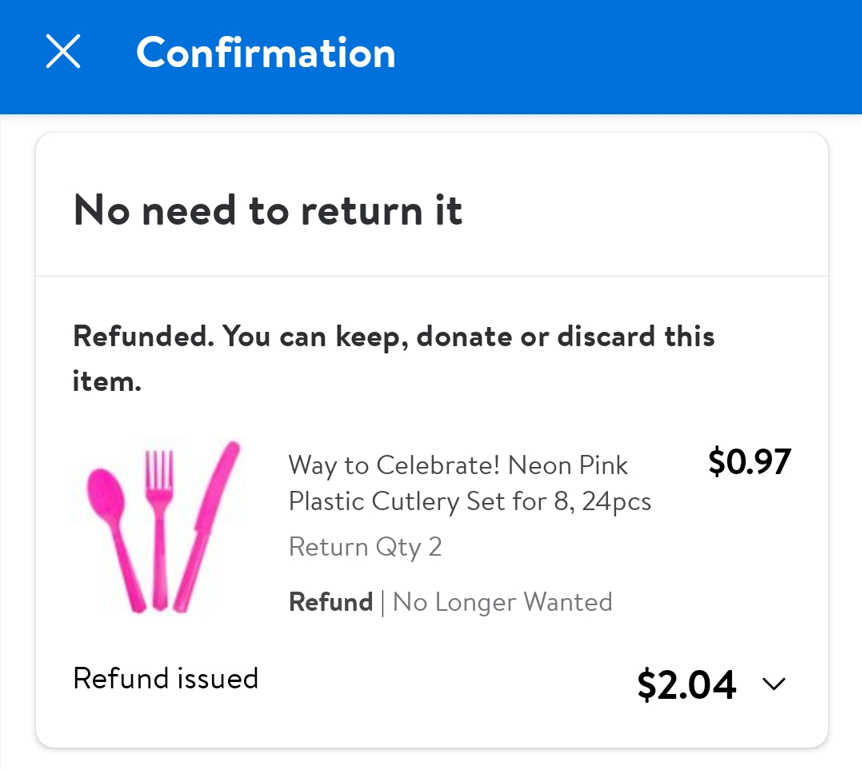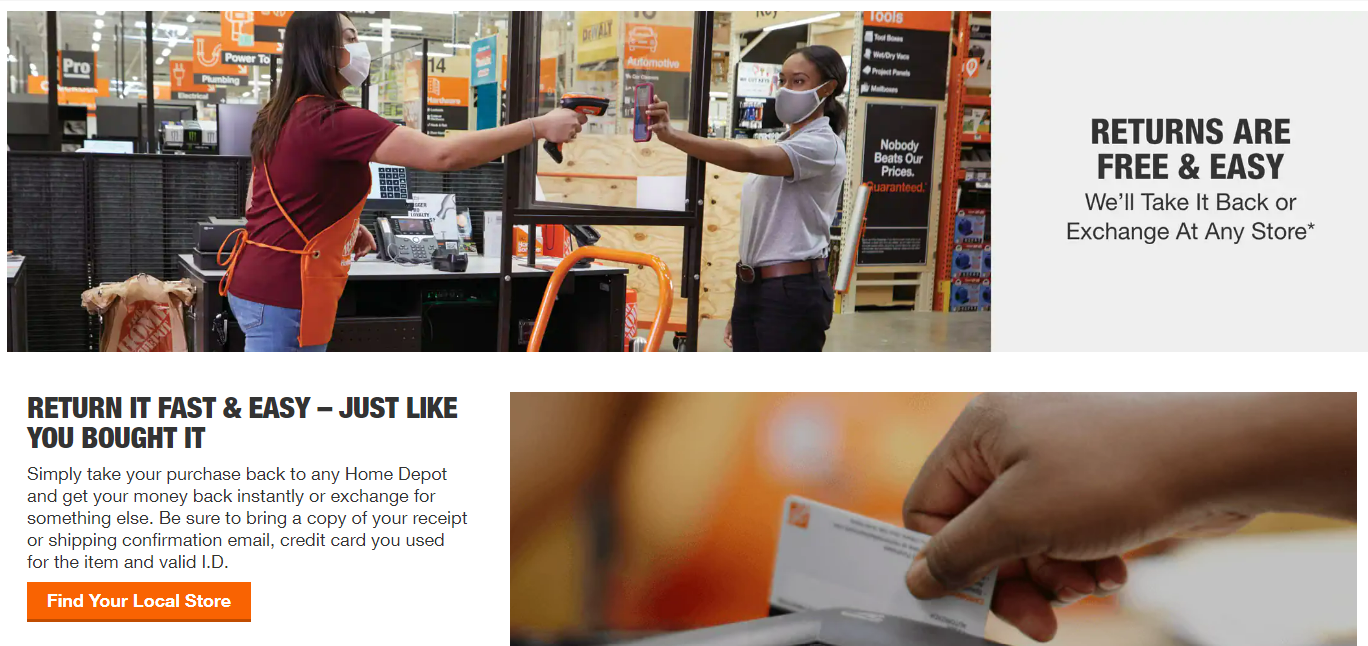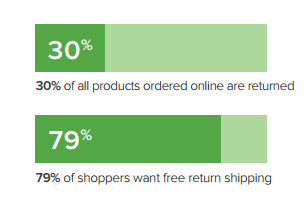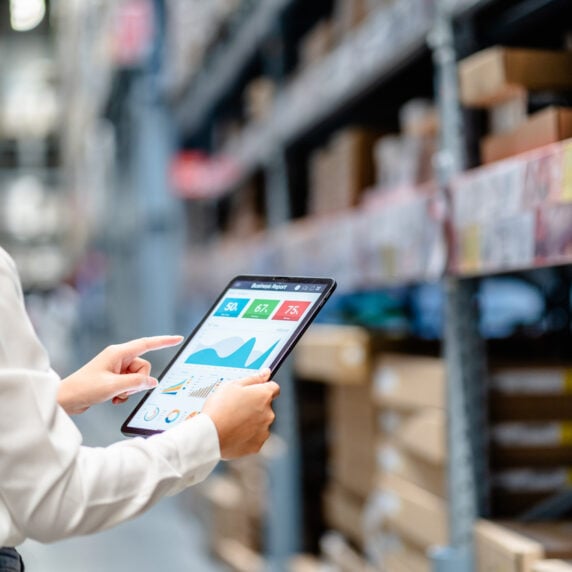Retail Returns: The Key to Driving Business Growth
Retail returns occur when a customer returns the purchased items to a seller in exchange for a refund, store credit, or a similar product.
Returns come with plenty of challenges around logistics, inventory, and predicting volatile sales trends. Yet, in today’s omnichannel world, retail returns are key to driving business growth, thanks to their ability to enhance the customer experience, minimize losses, and preserve long-term revenue.
Retail Returns Statistics Demonstrating the Path to Business Growth
It’s true that returns cost retailers money.
As Burt Flickinger, Retail Expert and Managing Director at retail consultancy Strategic Resource Group shared with CNN, “For every dollar in sales, a retailer’s net profit is between a cent to five cents. With returns, for every dollar in returned merchandise, it costs a retailer between 15 cents to 30 cents to handle it.”
Yet, managing merchandise returns with a policy that prioritizes customer satisfaction does benefit your company in the long run–particularly when you consider the impact returns have on the purchase decision of both existing and new customers.
This is demonstrated by the following statistics on retail returns:
- 92% of consumers are more likely to buy from a retailer again if they are given an easy returns process
- 76% of consumers say free returns are important consideration factors when shopping online
- 54% of buyers report that free returns or exchanges are the second biggest factor in determining if they will be returning shoppers
- 83% of consumers with a household income of over $100,000 report that returns are important
- 84% of buyers read the return policy before making an online purchase
- 62% of shoppers are more likely to buy online if they can return products to a physical store
Plus, more than 75% of retailers agree that retail returns are part of the business and should not be neglected.
Knowing the importance of managing the return of merchandise, let’s look at the goals and benefits of a customer-centric return policy. Then, we’ll delve into three of the latest trends and five steps you can take to best manage your returns.
The Goals of Customer-Centric Retail Returns
Whether selling your products in-store, online, or across channels, having the proper incentives for managing returns is crucial for customer satisfaction and confidence.
Here are the goals of a customer-centric retail returns policy:
- Create a positive customer experience through a seamless returns process
- Increase customer retention and long-term loyalty by demonstrating you put the customer first
- Build trust with existing customers and increase the likelihood they will purchase an alternative product from you if faced with stock-outs
- Minimize any risks consumers feel when making purchase decisions
As a retailer, you must plan a customer-centric returns strategy in order to build client trust and prevent negative reviews on social media, websites, and other channels where customers interact.
Benefits of Effective Management of Customer Returns
While returns are costly to retailers, the benefits and business gains of effectively managing retail returns far outweigh the losses by improving the customer lifetime value.
By keeping the customer experience at the center of your return policy, you enable sales to grow thanks to the increased referrals, return customers, and improved brand affinity.
According to a poll by Doddle, more than 80% of retail clients agree that the returns experience influences their opinion about a company.
In another example, Narvar’s study on “keep the item” returns demonstrates that:
- 65% of people appreciate that returnless refunds save them time and money
- 40% would be more likely to recommend the retailer to others
- 87% report that this “keep the item” experience alone increases the likelihood they’ll shop with the retailer again
Alternatively, handling returns poorly lowers customer loyalty, causing revenue loss and limiting company growth: 84% of customers would not return to a retailer following a bad returns experience.
Returns do more than drive growth. According to a report by Incisiv’s State of the Industry Report on Retail Returns, retailers can save up to $125 billion each year by focusing on reducing returns. It’s a missed opportunity, with Incisiv finding less than half of retailers track the impact of financial impact.
And, with 73% of returns occuring due to an action a retailer could have controlled, more accurate product descriptions, sending the wrong item, and working to avoid customers receiving damaged items all provide an opportunity for retailers to minimize returns while increasing working capital.
With every interaction, the aim is to give customers value for their money and safeguard the brand image. Your company’s interactions must provide customers with peace of mind and the confidence to become loyal to your brand.
The Latest Trends in Retail Returns
Retail returns are on the rise.
According to a survey conducted by the National Retail Federation (NRF) and Appriss Retail, retail returns increased to more than 16%, against 10.6% in 2020.
While this statistic exemplifies one of the latest challenges in retail trends, it also demonstrates why a customer-friendly return policy is so critical.
Here are three trends affecting retailers trying to leverage their return policy to gain a competitive advantage.
1. A Rise in ECommerce Sales and Online Retail Returns
The coronavirus pandemic led many businesses to rely on online sales, but it is a trend that’s here to stay – and one that has a direct impact on retail return rates.
Reports indicate that returns are higher when products are sold online, with an average return rate of 30% for ecommerce purchases, in comparison with 10% for brick-and-mortar sales.
Given the inability for consumers to physically see and touch products, it’s not surprising retailers face higher returns when selling on digital channels.
This increase in ecommerce sales is also why your return policy is critical to maintaining and building market share.
According to the U.S. Department of Commerce International Trade Commission, the percentage of retail sales sourced from ecommerce is predicted to increase into 2024–well beyond the lockdowns that caused the initial rise in ecommerce spend.
Another NRF report showed that online sales comprised 23% of all retail sales in 2021.
When you consider the fact that 30% of online shoppers purposely overbuy with the intention of returning what they don’t want, it’s worth considering how returns will factor into your demand forecasts if you’re selling via digital channels
2. Retailers Quietly Offering a “Keep the Item” Return Policy
Instead of product shortages, some retailers are on the opposite end of the spectrum struggling with excess inventory.
With major brands (such as Target and Walmart) facing record fuel prices, unanticipated changes in consumer spending habits, and other supply chain disruptions, many retailers are now facing an inventory glut.
From customer support and transportation to storage, processing and discounts, returns cost retailers a pretty penny.
Reverse logistics company Optoro estimates returning a $50 product costs retailers $33 in processing fees–or 66% of the item.
In light of this, some retailers are offering ‘returnless refunds’ where customers keep the product after getting a refund, avoiding additional freight charges and other fees.
According to a study by Narvar, 75% of consumers have been given a refund without needing to ship back the product.
Within the study, retailers commonly cited as offering unpublished “keep the item” offers include Amazon, Walmart, Wayfair, Chewy, Wish, Kohl’s, and Shein.
3. Buy Online Return In-Store (BORIS)
In an omnichannel world, customers want more than curbside pickup and the benefits of “buy online, pick up in-store” (BOPIS).
Now, customers also want the ability to return items in-store through “buy online, return in-store” (BORIS) offerings.
The policy can be burdensome for retailers because it complicates the assortment planning process.
Assortment planning is designed to create localized assortments that meet the needs of your customers across locations.
With assortment planning solutions, retailers are combining their insights with powerful AI to deliver the ideal assortment for each location.
Because of this, assortments by store can be radically different. BORIS results in out-of-assortment inventory that is usually only cleared at very low margins or through consolidation, or (even worse), ends up being a complete loss.
As a result, regardless of freight costs, seamless mail-in returns to the distribution center or ecommerce site are almost better for retailers.
Yet, offering in-store returns for online purchases is still being considered by retailers, with an increased number of stores implementing this system, such as IKEA, Bath and Body Works, Macy’s, and Home Depot.
If BORIS causes so many complications, what makes it worth the trouble?
The answer: the impact on purchase decisions. 62% of shoppers are more likely to purchase online if they can return the item in-store.
In-store returns also give customers a reason to return to your store, increasing the chance of repeat and impulse purchases.
5 Ways to Manage Retail Returns Effectively and Drive Long-Term Profitability
Approaches to managing returns differ depending on the nature of the business, target market, category, and products sold.
However, there are best practices that can be applied across business niches to ensure long-term profitability and operational success. These best practices exhibit values like consumer-friendliness, value for money, and efficiency in the return process without incurring additional costs.
Here, we’ll discuss five best practices retailers can use to differentiate themselves, create an optimal customer experience, and maximize market share.
1. Ensuring Fast, Free, and Easy Returns
Businesses must guarantee fast, free, and easy returns if they want to build consumer confidence, so look for ways to simplify each element for your customers.
Consider utilizing online tools to generate return shipping labels, text notifications, send email updates, or support a seamless omnichannel return experience through use of your store’s app.
Offering free returns minimizes the risk of buyer’s remorse, increasing the likelihood of purchase if consumers are on the fence.
It’s also what the vast majority of shoppers (79%) want from retailers.
Image source: Shipping Easy
Remember that part of making a return “easy” is clear communication. Never leave the customer stuck waiting or wondering what’s happening or what comes next.
You can also offer multiple return options from which customers can choose, such as in-person returns to third-party networks. This provides an immediate refund or exchange, assuring customers their hard-earned cash will quickly be back in their bank accounts and building trust to spend more with your business.
2. Keep an Eye on Your Competitors
Business owners always aim to get a competitive edge, so it helps to know what the competition is doing.
What are the return policies of your competitors? How well are they advertised? Is there anything you do–or could do–to win market share that they don’t?
Checking reviews and social media mentions of competitors is another way to understand the experience they provide customers.
About 72% of customers share negative reviews about bad return experiences. This dramatically impacts brand perception and can lead to a loss of future revenue.
A great return policy isn’t the only thing that will keep customers coming back.
3. Consider Lengthening Your Return Window
Stating you have a 14-day returns policy with store credit is easy. However, this approach lags behind customer expectations–particularly when competing with big-name retailers such as Amazon.
Instead of allowing 14 days, consider a period of 30, 60, or 90 days after the original purchase date. You can include reasonable exclusions and limitations to curb abuses from customers.
There’s an added benefit as well. According to a study by the University of Texas-Dallas, longer return windows actually reduced return rates.
4. Offer A Lenient Returns Policy That Puts Customer Needs First
When designing the policy, avoid being harsh and inconsiderate of customers’ situations and expectations. Empower in-store associates to make allowances when customers face extenuating circumstances.
You can also allow for more flexible options when outlining refund and exchange policies, such as allowing returns on sales items.
According to that same study from the University of Texas-Dallas, a more lenient returns policy like this can encourage customers and help them make purchases with more confidence.
5. Automate Retail Returns and Exchanges
Automation of the return flow can enhance customer experience and company growth, but that’s not the only benefit of automation.
Automating the exchange of faulty products improves the customer experience by offering the opportunity to choose an alternative, similarly priced product from the online shop, instead of receiving monetary refunds.
Either way, automation makes for an easy customer experience that will encourage brand loyalty.
Building a Better Customer Experience with Retail Returns
Studies continually show that retaining at least 5% of your clients increases profits by more than 95%. Since a good returns policy is key to that retention and long-term business growth, make sure that the returns process is convenient and hassle-free, and demonstrate empathy to clients.
For more ways to keep customers returning to your brand–and to minimize returns–ensure you’ve got the right product mix to maximize return purchases.
Get the Ultimate Guide to Collaborative and Profitable Assortment Planning now and discover how to create assortments your customers will love that deliver optimal results for retailers.



